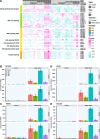Drought tolerance of the grapevine, Vitis champinii cv. Ramsey, is associated with higher photosynthesis and greater transcriptomic responsiveness of abscisic acid biosynthesis and signaling
- PMID: 32019503
- PMCID: PMC7001288
- DOI: 10.1186/s12870-019-2012-7
Drought tolerance of the grapevine, Vitis champinii cv. Ramsey, is associated with higher photosynthesis and greater transcriptomic responsiveness of abscisic acid biosynthesis and signaling
Abstract
Background: Grapevine is an economically important crop for which yield and berry quality is strongly affected by climate change. Large variations in drought tolerance exist across Vitis species. Some of these species are used as rootstock to enhance abiotic and biotic stress tolerance. In this study, we investigated the physiological and transcriptomic responses to water deficit of four different genotypes that differ in drought tolerance: Ramsey (Vitis champinii), Riparia Gloire (Vitis riparia), Cabernet Sauvignon (Vitis vinifera), and SC2 (Vitis vinifera x Vitis girdiana).
Results: Ramsey was particularly more drought tolerant than the other three genotypes. Ramsey maintained a higher stomatal conductance and photosynthesis at equivalent levels of moderate water deficit. We identified specific and common transcriptomic responses shared among the four different Vitis species using RNA sequencing analysis. A weighted gene co-expression analysis identified a water deficit core gene set with the ABA biosynthesis and signaling genes, NCED3, RD29B and ABI1 as potential hub genes. The transcript abundance of many abscisic acid metabolism and signaling genes was strongly increased by water deficit along with genes associated with lipid metabolism, galactinol synthases and MIP family proteins. This response occurred at smaller water deficits in Ramsey and with higher transcript abundance than the other genotypes. A number of aquaporin genes displayed differential and unique responses to water deficit in Ramsey leaves. Genes involved in cysteine biosynthesis and metabolism were constitutively higher in the roots of Ramsey; thus, linking the gene expression of a known factor that influences ABA biosynthesis to this genotype's increased NCED3 transcript abundance.
Conclusion: The drought tolerant Ramsey maintained higher photosynthesis at equivalent water deficit than the three other grapevine genotypes. Ramsey was more responsive to water deficit; its transcriptome responded at smaller water deficits, whereas the other genotypes did not respond until more severe water deficits were reached. There was a common core gene network responding to water deficit for all genotypes that included ABA metabolism and signaling. The gene clusters and sub-networks identified in this work represent interesting gene lists to explore and to better understand drought tolerance molecular mechanisms.
Keywords: Abscisic acid; Drought; Galactinol synthases; Grapevine; Transcriptomics; Vitis; Water deficit.
Conflict of interest statement
The authors declare that they have no competing interests. Grant R. Cramer is a member of the editorial board (section editor) of this journal.
Figures











Similar articles
-
Transcriptomic network analyses of leaf dehydration responses identify highly connected ABA and ethylene signaling hubs in three grapevine species differing in drought tolerance.BMC Plant Biol. 2016 May 23;16(1):118. doi: 10.1186/s12870-016-0804-6. BMC Plant Biol. 2016. PMID: 27215785 Free PMC article.
-
ABA-mediated responses to water deficit separate grapevine genotypes by their genetic background.BMC Plant Biol. 2016 Apr 18;16:91. doi: 10.1186/s12870-016-0778-4. BMC Plant Biol. 2016. PMID: 27091220 Free PMC article.
-
Transcriptomic response is more sensitive to water deficit in shoots than roots of Vitis riparia (Michx.).BMC Plant Biol. 2019 Feb 13;19(1):72. doi: 10.1186/s12870-019-1664-7. BMC Plant Biol. 2019. PMID: 30760212 Free PMC article.
-
The physiology of drought stress in grapevine: towards an integrative definition of drought tolerance.J Exp Bot. 2020 Aug 6;71(16):4658-4676. doi: 10.1093/jxb/eraa245. J Exp Bot. 2020. PMID: 32433735 Free PMC article. Review.
-
Abscisic Acid Mediates Drought and Salt Stress Responses in Vitis vinifera-A Review.Int J Mol Sci. 2020 Nov 17;21(22):8648. doi: 10.3390/ijms21228648. Int J Mol Sci. 2020. PMID: 33212767 Free PMC article. Review.
Cited by
-
Rootstock influences the effect of grapevine leafroll-associated viruses on berry development and metabolism via abscisic acid signalling.Mol Plant Pathol. 2021 Aug;22(8):984-1005. doi: 10.1111/mpp.13077. Epub 2021 Jun 1. Mol Plant Pathol. 2021. PMID: 34075700 Free PMC article.
-
Arbuscular Mycorrhizal Fungi Improve the Performance of Tempranillo and Cabernet Sauvignon Facing Water Deficit under Current and Future Climatic Conditions.Plants (Basel). 2024 Apr 22;13(8):1155. doi: 10.3390/plants13081155. Plants (Basel). 2024. PMID: 38674564 Free PMC article.
-
Toward understanding grapevine responses to climate change: a multi-stress and holistic approach.J Exp Bot. 2025 Aug 5;76(11):2949-2969. doi: 10.1093/jxb/erae482. J Exp Bot. 2025. PMID: 39589787 Free PMC article. Review.
-
VviERF6Ls: an expanded clade in Vitis responds transcriptionally to abiotic and biotic stresses and berry development.BMC Genomics. 2020 Jul 9;21(1):472. doi: 10.1186/s12864-020-06811-8. BMC Genomics. 2020. PMID: 32646368 Free PMC article.
-
The Rootstock Genotypes Determine Drought Tolerance by Regulating Aquaporin Expression at the Transcript Level and Phytohormone Balance.Plants (Basel). 2023 Feb 6;12(4):718. doi: 10.3390/plants12040718. Plants (Basel). 2023. PMID: 36840066 Free PMC article.
References
-
- Stagnari F, Galieni A, Pisante M: Drought stress effects on crop quality. In: Water Stress and Crop Plants: A Sustainable Approach. Edited by Ahmad P; 2016: 375–92.
-
- Tardieu F: Plant tolerance to water deficit: physical limits and possibilities for progress. C R Geosci 2005, 337(1-2):57–67.
-
- Schultz HR. Differences in hydraulic architecture account for near-isohydric and anisohydric behaviour of two field-grown Vitis vinifera L. cultivars during drought. Plant, Cell & Environment 2003;26(8):1393–405.

